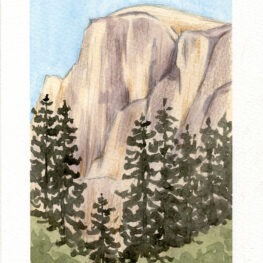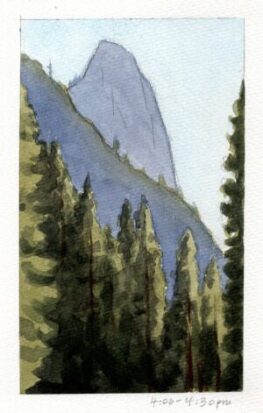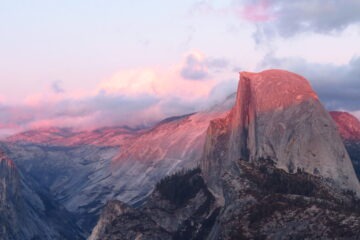For artist and educator Andrea Dingeldein, creating art that is merely beautiful, emotionally moving, or impressive isn’t always enough. (Don’t get her wrong, she still thinks there’s great value in art that isn’t scientific in nature!) What draws her to scientific illustration is the fact that her work has an additional purpose: to communicate information and inspire others to protect and care for their natural surroundings. She finds that by collaborating with scientists in producing some of her artwork, she is constantly advancing her knowledge of and curiosity about the natural world.

Half Dome by Andrea Dingeldein
We’re excited to announce that artist and educator Andrea is teaching a Field Sketching Retreat with us this August and wants to help visitors channel their curiosity about all things Yosemite! This retreat is open to all skill levels, including those who are just beginning to tap into their inner creative.
Below are excerpts from a Q&A with artist and educator Andrea Dingeldein about her creative process.
Can you remember when you first started drawing and painting? Do you have any special memories or inspirations?
I started drawing as soon as I could hold a crayon. Both my mother and grandmother were artists, so I was always given art supplies at the kitchen table to keep me occupied. My early drawings were just scribbles, but I soon moved on to more complex subjects, such as the insects that I’d capture and study in my backyard.
What is the most satisfying part of being an artist and educator?
The most exciting part of being an art educator is seeing the magical work that students create. I mostly teach students how observe and record subjects accurately, rather than teaching them to copy a particular style of painting or drawing. It’s so rewarding to see that “a-ha” moment when a student’s perspective and understanding of a subject shifts. I also learn SO much from students—they teach me about natural subjects, ask thoughtful questions, and encourage me to keep adding to my skillset. This, in turn, makes me a better educator.
Do you ever struggle to make time for creating when out on camping, hiking, or backpacking trips? If so, what helps?

Sentinel Rock by Andrea Dingeldein
I think the most challenging part of finding time to create while in the wilderness is that I’m not always traveling with other people who are inspired to create. To get around this hurdle, I’ll often voice my desire to make time for a sketch at the beginning of a hike. Then I’ll strategically sketch while we are breaking for a snack or a rest.
I usually don’t get the chance to finish the sketches that I start in the field, but if there’s time when we get back to camp, I’ll finish it by the last light of the day. If I’m feeling really inspired, I’ll finish sketches by headlamp (though I don’t recommend this, as the colors are often skewed!).
Another tip is to do some quick sketches at sunrise or sunset—the changing light forces you to work quickly, and this is usually “down time” at camp.
How do you work through creative block as an artist and educator?
I usually avoid pushing creativity. I ask myself what I need in my everyday life to light the creative fire in me. Often, the answer is a long walk in the woods, or a trip to explore the coastal tidepools. I’m not the sort of artist that necessarily draws every day: sometimes I go weeks without creating anything.
But I try to recognize that I am still doing work when I am out hiking and asking questions about nature. During those times I am growing in knowledge of the natural world and taking the time to observe things closely. That all translates to my creative practice. Some days, I’ll wake up and suddenly want to paint all day and through the night. It’s important to give yourself that time when you feel the creative fire.
If you could give a tip (or two) to someone who wants to practice more creativity in their day to day but struggles to make the time/space for it, what would you say?
Start simple. If you don’t have a lot of time, don’t set out to do an ambitious painting! Do a quick pencil sketch, or just record swatches of color from your surroundings. Don’t put pressure on yourself—it’ll make it worse! Always have your sketching kit with you, and when you have 10 minutes of time to take in your surroundings, break that sucker out and put something down on paper! If you don’t have time to draw, then write.
What are you most excited about for your upcoming Yosemite retreat?
There’s no place on Earth quite like Yosemite. I’m really looking forward to guiding participants in capturing the essence of Yosemite’s landscape in their sketches—from the magnitude of the looming rockfaces to the details in a grasshopper’s wing. I’m also looking forward to cultivating a supportive space for everyone to slow down, create, share, and reflect.

Half Dome by Andrea Dingeldein
All of the Yosemite artwork on this page is courtesy of artist and educator Andrea Dingeldein.
For more information about current classes and retreats, please visit the Conservancy Art Center page.
For any questions about Andrea’s 2024 Art Retreat, please email art@yosemite.org!
There is also still space available for art retreats with Rachel Fisher, Cheyenne Sukalski, Casey Cheuvront, and Joa Suorez and Kelly Lee (as of February 8, 2024).



